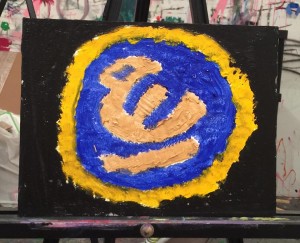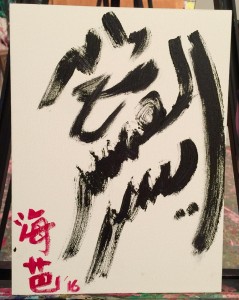Preface
Aesthetic and Interpretive Understanding 54:
For the Love of God and His Prophet:
Religion, Literature, and Arts in Muslim Cultures
Professor Ali Asani
Spring 2016
Preface
This is my second class with Professor Asani, and I feel that I have come a long way since I have taken my first class with Professor Asani sophomore year. Growing up in Egypt, I wasn’t exposed too much to how diverse the Muslim community really is. There are 1.6 billion Muslims in the world, and, for some reason, when I was younger, I thought there was only one version of Islam, one way to call for prayer, and one core belief system. I was always aware that there are different Muslims because I have met people from different Muslim backgrounds in China and other Arab countries. However, I never realy gave it too much thought until I took Professor Asani’s class.
Though the core values of Islam and its teachings are the same, people actually have very different beliefs, traditions and myths. Throughout the class, we were exposed to different forms of recitations, poetry, stories and traditions. The culture of every place strongly affects how the interpret Islam, the Quran and the hadith, that is why the “Cultural Studies Approach,” is so fascinating and crucial for learning Islam. From this class, I have learned that Islam can never be learnt out of context, and if you want to understand the Islam of a specific region, you have to understand the culture of the place Islam grew in to be able to differentiate what is attributed to Islam and what is attributed to the culture of this area.
This is a very important lesson that needs to be understood by anyone studying Islam or the Middle East or any other Muslim country. In fact, religious pluralism within Islam needs to be studied and accepted by both Muslims and non-Muslims. It is rather ironic that most people of our time are on both extremes; people either generalize and think all Muslims are the same everywhere, or they think that they are very different to the point that they cannot get along with each other. The former is more reflective of non-Muslims who haven’t had enough exposure to many Muslims communities, and the latter is more reflective of Muslims, who think their differences are so vast, that they can never communicate with each other effectively economically or politically, and a great example of that is Iran and Saudi Arabia.
The class’s emphasis on the cultural studies approach and religious pluralism within Islam, I believe, are some of the most important lessons we have learned in class due to their relevance to a lot of other topics that are very important for us to understand nowadays, especially politics-related. Having these two lessons in mind completely changes how we approach the news we see and hear daily. Being able to ask ourselves why we think the way we do and where our information related to a certain topic gives us the opportunity to objectively analyze situations and credibility when discussing these issues with other people. Also, just being able to get exposed to so many different cultures, traditions and music in the period of a semester is really eye opening. It feels as if we traveled to those countries and got to know the people there. Now, whenever we visit Iran, Pakistan or Indonesia, we won’t be too surprised or too culturally shocked when we meet the people and see the countries.
Another important theme in this class is art. From this class, I have learned that a lot of things can be considered art and it’s people emotion and reactions to something that makes it art. Art can be anything, if it makes people feel a certain way. Throughout the class, we have learned about different types of music, dances, songs, poetry, paintings, prose, calligraphy, architecture among others, and the list goes on. I was never really excited about art. I had never been really good at expressing myself through art, and maybe that is why I was never very excited about it. However, after this class, seeing how much other people were able to express themselves through art is extremely fascinating. People were able to say so much more using one poem or one painting than they could have by directly expressing how they feel in words.
It really showed me how important art is in our society and how much it signifies and symbolizes people’s beliefs and thoughts. All the dances, songs, recitations and performances we have seen were able to give us a very pure, raw look at people, how they feel and what these beliefs mean to them. The different forms of art represented in class were also very mesmerizing. Though not everyone is talented in the same skills, it showed me that art can be anything you want it to be and you can be good at some for or the other. Looking at the architectures of a lot of mosques was also wonderful. Being able to understand how a building came into being and the thought process behind why a specific building looks the way it does also taught me a lot about what goes in the head of an architect and how much culture influences the design of buildings.
Being able to create artwork for the class was also a great experience. After getting to see all these different art forms in class, it was great to be able to think like an artist and design 6 different artworks. For my 6 pieces of artwork, I followed two themes: one is religious pluralism and religious empowerment.
Coming in freshman year, it was very interesting for me to see how different my belief system was from my roommates’ belief systems. One of them was Sikh, one was Catholic and the third one was Christian. Though we got along perfectly and shared the same core values and morals, I kept wondering how we all believe equally strongly in what we believe in and how so many groups of people in so many different continents somehow reached the same conclusion when it came to faith and religion. It seemed unreasonable that one group would be right and the other wrong. We either were all right and we all believed in the same truth but with different names and were following different paths to that same truth, or we were all wrong.
These were very interesting conclusions to reach, and I was very happy when I heard Professor Asani talking about how most influential, spiritual leaders of different communities can be considered prophets. In the first week of Professor Asani’s other class, he talked about how Buddha, Confucius, Jesus, Moses and Muhammad were all prophets of God that came to earth to guide humanity and enlighten them, and how essentially all religions stem from the same creator, which sounds very logical. Thus, for 4 of my 6 artworks, I decided to address this theme.
In Week 4, I tried to picture the idea of how Allah has sent so many prophets throughout time to different communities. I tried to represent that through some holiday lights. Each of the light bulbs represented a prophet, and collectively they represent the light of “Allah” on earth, guiding and aiding humanity together, throughout different time periods. In Week 7, I also tried to address this theme from a different perspective. I tried to draw our planet earth. The continents represented the word Allah, and I took a snapshot of the earth from outer space. The idea was that our core values are all the same and that there is essentially one truth, and we are all trying to get there throughout different directions and paths.
Week 2 represented the mix of two different cultures. I was very inspired by a painting by a famous Chinese calligrapher that drew Arabic words with a Chinese style, which I have felt was the perfect representation of my mixed background. I tried to do something similar for my artwork to prove that cultures can, in fact, be mixed and the results can do justice to two cultures. Week 3 represented nature and how sacred nature can be. Giving ourselves the chance to look at the world, listen to the sounds it has and look at all the amazing living organisms on it can be very spiritual. This is exactly how Abraham found god.
Week 6 and Week 10 tackle a different theme. It is a theme about religious empowerment. For Week 10, I created a Muslim version of the Powerpuff Girls to empower young Muslim girls everywhere in the world and give them superheros that look like them that they can look up to. I tried to create them in a way that they were very diverse and representative of how different Muslims are in the world. For Week 6, I created a ring design that symbolizes knowledge for it to be given to Muslim scholars who accomplish a lot academically. It is a design of the word, “Read” in Arabic, which is also the first Quranic verse to to be recited to prophet Muhammad, to symbolize the importance of knowledge.
All in all, it has been an amazing class that I am really glad I had the opportunity to take. I have learned so much; I had the opportunity to think of topics that I have always wanted to think about, explore the artistic side of me, explore so many cultures and traditions and have intellectually-stimulating discussing with amazing students. All this wouldn’t have been possible without the contributions of Professor Asani, Ceyhun and John, so thank you so much for an amazing semester and class!












